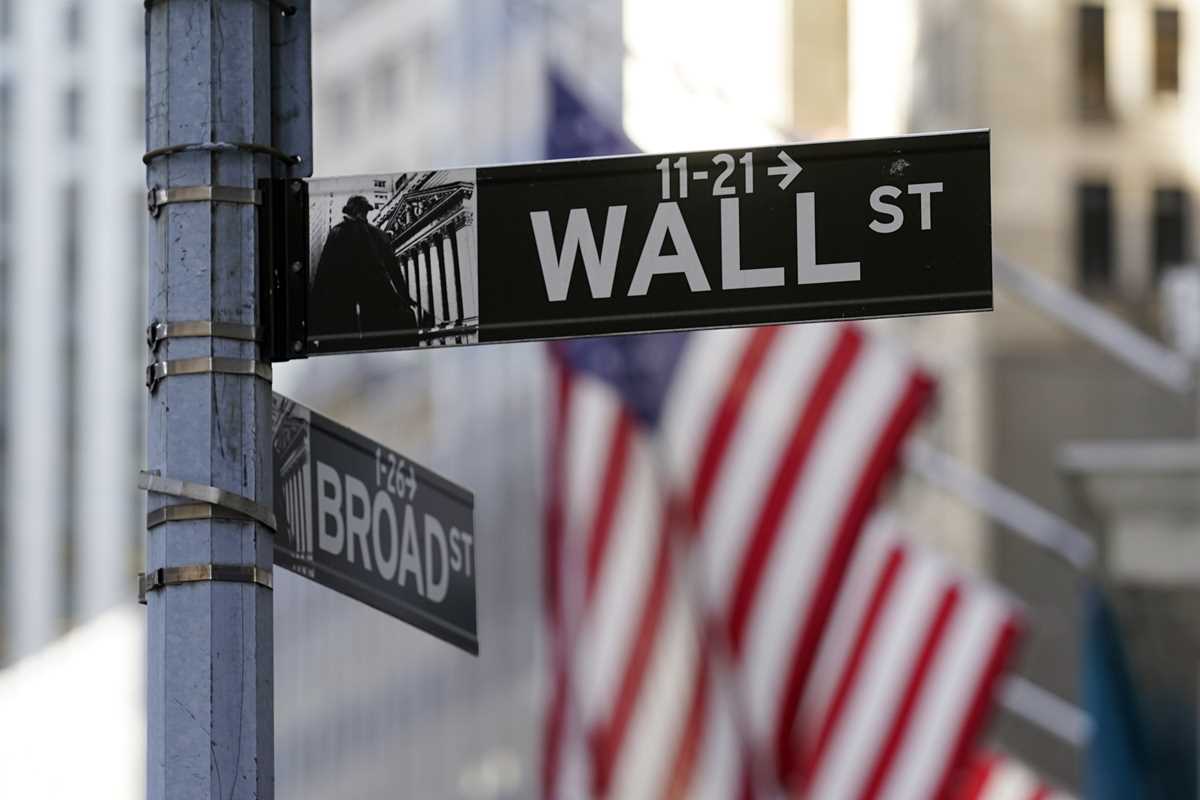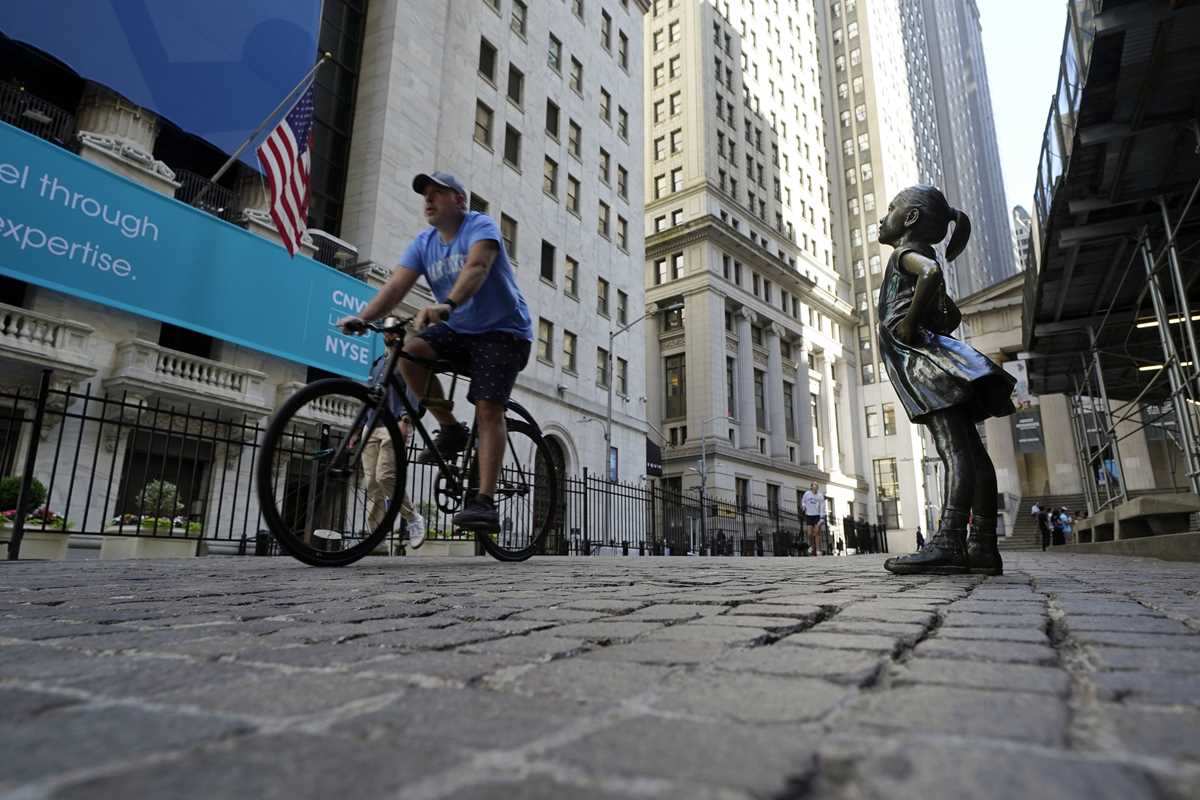 Flags adorn the facade of the New York Stock Exchange, Wednesday, June 16, 2021. Stocks are off to a mixed start on Wall Street Wednesday as traders wait for the latest decision on interest rates from the Federal Reserve. (AP Photo/Richard Drew)
Flags adorn the facade of the New York Stock Exchange, Wednesday, June 16, 2021. Stocks are off to a mixed start on Wall Street Wednesday as traders wait for the latest decision on interest rates from the Federal Reserve. (AP Photo/Richard Drew) People pass an entrance of the New York Stock Exchange, Wednesday, June 16, 2021. Stocks are off to a mixed start on Wall Street Wednesday as traders wait for the latest decision on interest rates from the Federal Reserve. (AP Photo/Richard Drew)
People pass an entrance of the New York Stock Exchange, Wednesday, June 16, 2021. Stocks are off to a mixed start on Wall Street Wednesday as traders wait for the latest decision on interest rates from the Federal Reserve. (AP Photo/Richard Drew) The "Fearless Girl" statue faces the New York Stock Exchange, Wednesday, June 16, 2021. Stocks are off to a mixed start on Wall Street Wednesday as traders wait for the latest decision on interest rates from the Federal Reserve. (AP Photo/Richard Drew)
The "Fearless Girl" statue faces the New York Stock Exchange, Wednesday, June 16, 2021. Stocks are off to a mixed start on Wall Street Wednesday as traders wait for the latest decision on interest rates from the Federal Reserve. (AP Photo/Richard Drew)NEW YORK (AP) — U.S. stocks fell and bond yields climbed Wednesday after the Federal Reserve signaled it may start easing off the accelerator on its massive support for the economy earlier than previously thought.
The S&P 500 fell 22.89, or 0.5%, to 4,223.70 after the Fed unveiled a highly anticipated set of projections by its policymakers, which showed some expect short-term rates to rise half a percentage point by late 2023. The Fed’s chair also said it has begun talking about the possibility of slowing down the bond purchases it makes every month to keep longer-term rates low.
Super-low interest rates have been one of the main sources of fuel for the stock market’s rocket ride to records, with the most recent coming on Monday. That’s why the immediate reaction for investors to the Fed’s comments was to send stocks lower and bond yields higher, and the S&P 500 lost as much as 1% in the afternoon. But the moves moderated as the Fed’s chair, Jerome Powell, said in a press conference that any changes are likely still a ways away.
The Dow Jones Industrial Average fell 265.66 points, or 0.8%, to 34,033.67, paring a loss that hit 382 points shortly after the Fed’s announcement. The Nasdaq composite fell 33.17, or 0.2%, to 14,039.68 after earlier being down 1.2%.
In the bond market, the yield on the 10-year Treasury climbed to 1.55% from 1.50% late Tuesday. The two-year yield, which moves more closely with expectations for Fed policy, rose to 0.20% from 0.16%.
After getting over the surprise of seeing several policymakers move up forecasts for raising rates, Nate Thooft, senior managing director at Manulife Investment Management, said that his focus turned to their projections for inflation and the economy’s growth. Neither changed much for next year or for the long term.
“To me, that says the confidence level they have in their outlook is higher, not that their outlook has changed,” Thooft said.
Before, uncertainty about the economy’s recovery from the pandemic may have forced Fed officials to push the timeline for rate hikes further into the future. Now, with widespread vaccinations helping to send the economy roaring out of its prior coma, the central bank may be feeling more confident.
But moving up the timeline for rate hikes probably also moves up the timing for a potential slowdown in the Fed’s bond purchases.
In his press conference following the Fed’s announcement, Powell said that would be the bigger near-term change for markets. He said again that the purchases will continue until “substantial further progress has been made” in getting the economy to full employment and prices to be stable.
But he acknowledged that conditions have improved enough to start discussing when to taper the purchases. “You can think about this meeting as the ‘talking about talking about’ meeting,” he said.
That has some investors circling late August on the calendar, when the Federal Reserve Bank of Kansas City will host its annual symposium in Jackson Hole, Wyoming. That gathering has been the setting for big Fed pronouncements in the past, and maybe that's when Powell will offer more guidance about when the taper will begin.
A recent burst of inflation had raised concerns that the Fed will have to tighten the spigot on its support. Prices are leaping for used cars, airfares and other things across the economy as it hurtles back to life. The consumer price index surged 5% in May from a year earlier, for example.
Fed policymakers on Wednesday raised their expectations for inflation this year. The median projection for the Fed’s preferred measure of inflation was for 3.4%, up from 2.4% in March.
But the Fed still sees the burst being only temporary as the economy works its way through supply shortages and other short-term factors. The median projection sees inflation dropping to 2.1% next year and 2.2% in 2023. That’s up only slightly from their earlier projection of 2% for 2022 and 2.1% for 2023, made in March.
For economic growth in 2022, the median projection for policymakers held steady at 3.3%. For 2023, it rose to 2.4% from an earlier projection of 2.2%.
Within the S&P 500, four stocks fell for every one that rose. One of the biggest losses came from Oracle, which fell 5.6% after it laid out investment plans that could drag on its upcoming profitability.
Furniture company La-Z-Boy fell 11.7% after warning investors that dramatically higher prices it’s paying for raw materials will drag down how much profit it makes from every $1 of sales.
General Motors was among the few gainers. It rose 1.6% after saying it will raise spending on electric and autonomous vehicles and add two U.S. battery factories.
Before you consider TWO, you'll want to hear this.
MarketBeat keeps track of Wall Street's top-rated and best performing research analysts and the stocks they recommend to their clients on a daily basis. MarketBeat has identified the five stocks that top analysts are quietly whispering to their clients to buy now before the broader market catches on... and TWO wasn't on the list.
While TWO currently has a "hold" rating among analysts, top-rated analysts believe these five stocks are better buys.
View The Five Stocks Here
Thinking about investing in Meta, Roblox, or Unity? Click the link to learn what streetwise investors need to know about the metaverse and public markets before making an investment.
Get This Free Report